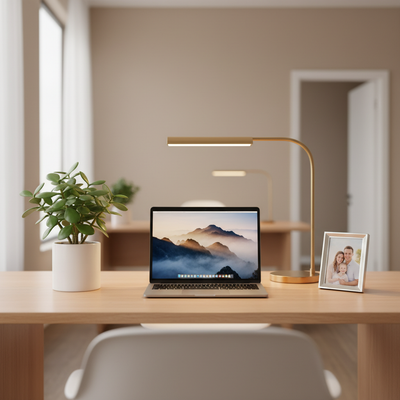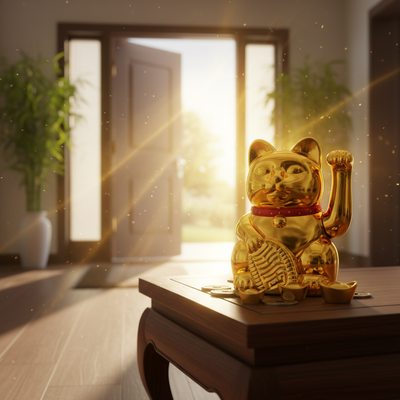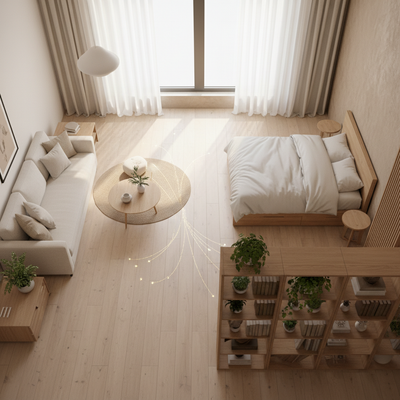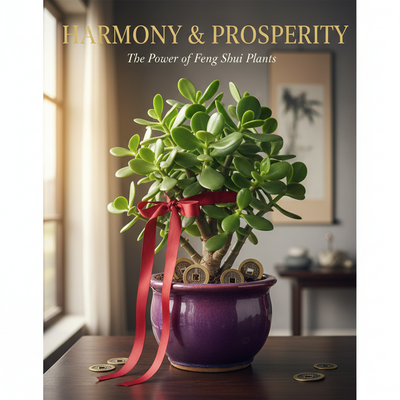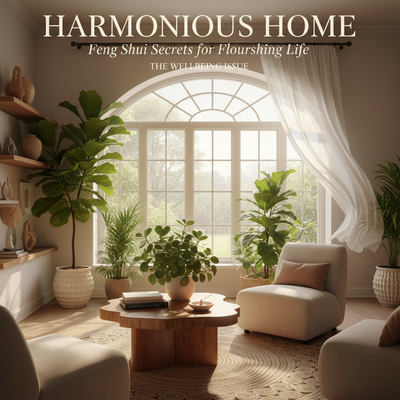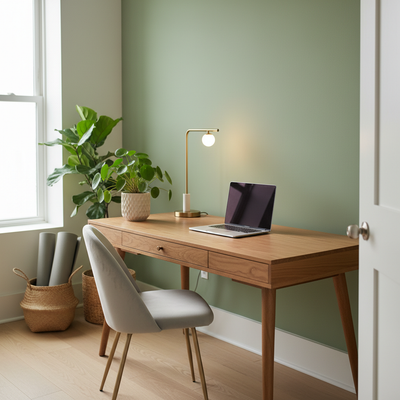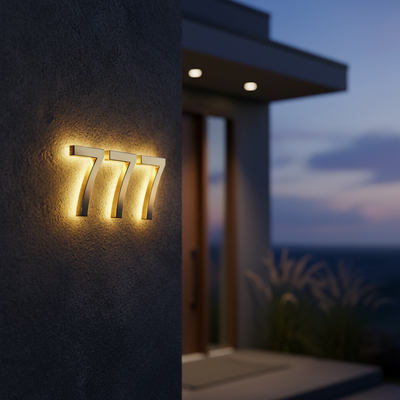In Feng Shui, your bedroom is a special place for rest and renewal. To keep this peaceful energy, you need to avoid colors that are too exciting or drain your energy. The main feng shui colors to avoid bedroom are bright reds, vivid oranges, strong yellows, dark blues or blacks, and too much pure white. Each of these colors brings energy that fights against the peace and calm you need for good sleep and healthy relationships.
While knowing what colors to avoid is the first step, understanding why helps you master your home's energy. This guide will explain the feng shui colors to avoid bedroom and also teach you the basic Feng Shui ideas behind these choices. We will give you practical solutions if your room is already painted one of these colors and show you the best colors for peace, love, and restful sleep. This is your path to creating a true safe space.
The "Why": Color and Energy

To make smart choices, you first need to understand how color affects a room's energy. This isn't about random rules; it's about an ancient system for creating balance that has worked for hundreds of years. By learning two main ideas—Yin and Yang, and the Five Elements—you can move from simply following advice to naturally creating a space that helps your well-being.
The Bedroom's Yin Purpose
In Feng Shui, every space has a main energy type, either Yin or Yang. Yang energy is active, bright, loud, and growing. It's the energy of a busy kitchen, a sunny living room, or a productive home office. It powers activity, conversation, and growth.
The bedroom, however, is the perfect Yin space in your home. Its main purpose needs energy that is quiet, peaceful, dark, soft, and healing. It is the place where you escape from the world to recharge your body, mind, and spirit. When you bring too much Yang colors and items into a Yin space, you create an energy fight. This imbalance often causes restlessness, poor sleep, and even relationship problems, as the room's energy fights against its main purpose.
The Language of Color
The Five Elements Theory is the system Feng Shui uses to understand all energy, including the energy of color. These elements are Wood, Fire, Earth, Metal, and Water. Each element has its own quality and connects to specific colors, shapes, and materials. The goal in the bedroom is not to remove any element, but to create a peaceful mix that supports the room's main Yin function.
- Fire Element: Reds, Oranges, Bright Pinks (Energy: Passion, High Energy, Growth)
- Earth Element: Yellows, Sandy Colors, Light Browns (Energy: Stability, Grounding, Care)
- Metal Element: Whites, Grays, Metallics (Energy: Clarity, Sharpness, Purity)
- Water Element: Blues, Blacks (Energy: Flow, Deep Thinking, Stillness)
- Wood Element: Greens, Teals (Energy: Growth, Healing, Life)
Understanding this system helps you see that painting a room bright red isn't just a design choice; it's like lighting a campfire in a space meant for quiet thinking. The energy is simply too powerful and active for rest.
The Problem Colors: 5 Colors to Avoid
Now that we've explained the 'why,' let's look at the specific colors to avoid for your bedroom walls and large furniture. These colors bring too much or wrong energy that can disturb the harmony of your personal safe space.
1. Bright Reds
Red is the color of the Fire element in its strongest Yang form. It is a color of power, passion, fame, and intense activity. While a small touch of red can be a wonderful accent to invite romance and passion into a relationship, using it as a main wall color is too aggressive. It basically puts the room in a constant state of high alert, making it nearly impossible for your nervous system to fully relax and enter deep sleep.
Possible Negative Effects:
* Trouble falling asleep, sleeplessness, and restlessness.
* More arguments, anger, and irritation in relationships.
* Can lead to feelings of worry or being constantly "on edge."
* May cause higher blood pressure and a sense of energy "fever."
2. Dark Blue and Black
This might surprise you, as blue is often linked with calm. However, in Feng Shui, dark, deep blues and black represent the Water element at its strongest. While a balanced Water element means flow and thinking, too much of it creates an energy of drowning and being stuck. A room filled with these colors can feel heavy, crushing, and sad. Color psychology studies have also found that large, poorly lit spaces painted in dark blue or black can make feelings of sadness worse.
Possible Negative Effects:
* Can add to feelings of sadness, depression, or hopelessness.
* Creates a heavy, stuck energy that stops motivation and makes it hard to get up in the morning.
* May create a sense of loneliness or emotional withdrawal.
* In some Feng Shui schools, it is considered bad luck for money, representing energy and wealth "draining away."
3. Bright, Exciting Yellows
The Earth element, shown by yellow, is generally good for a bedroom when the tones are soft, sandy, and caring. However, bright, electric yellows—like lemon, sunflower, or canary yellow—are highly exciting. This intense vibration is more like the Fire element. It's a color that encourages appetite and lively conversation, which is why it is often used in kitchens and dining areas. In the bedroom, this same energy becomes a source of mental worry. It's an interesting fact that in early studies with babies, rooms painted bright yellow were seen to cause more crying.
Possible Negative Effects:
* Promotes nervous energy and mental chatter that prevents the mind from quieting down.
* Can feel jarring and unsettling rather than caring and stable.
* May overstimulate the nervous system, leading to restless, light sleep.
4. Bright Orange
Much like red, orange is a strong Fire element color. It is known for being social, creative, and joyful. It is an energy that wants to party, create, and talk. While this is a wonderful energy for a family room or a creative studio, it fights against the purpose of a bedroom. A room painted in bright orange constantly tells your brain to be active and engaged, making it very difficult to move into a state of rest. The energy is simply too loud and excited for a space meant for quiet renewal.
Possible Negative Effects:
* Promotes wakefulness and activity, directly leading to poor sleep quality.
* Can feel overwhelming and prevent the experience of deep relaxation.
* May create a feeling that the room is never truly "at rest" or peaceful.
5. Stark, "Hospital" White
This is the most common mistake we see. People choose white for its seeming simplicity and cleanliness. In Feng Shui, however, a stark, clinical, blue-toned white is an expression of the Metal element in its harshest form. This type of white is too sterile, sharp, and reflective. It bounces light around aggressively, creating a very active, Yang energy that is not good for sleep. It lacks the soft, caring, "cocooning" quality that a bedroom needs to feel safe and comforting. The goal isn't to avoid white completely, but to be very specific about the type of white you choose.
Possible Negative Effects:
* Can feel cold, lonely, and emotionally isolating.
* The high reflectivity can disrupt sleep, especially if there is ambient light from windows or electronics.
* Lacks the caring quality needed for a restful and sensual space.
Beyond the List: Details and Mistakes
Feng Shui is a sophisticated practice, not just a list of dos and don'ts. True harmony comes from understanding the details and avoiding common mistakes. Simply knowing which colors to avoid is only half the battle; knowing how to apply these principles with balance and purpose is what creates a truly supportive space.
The Problem of Too Much
A critical principle in Feng Shui is that too much of any one thing, even a "good" thing, creates imbalance. For example, a bedroom painted entirely in a soft, earthy beige—a recommended Earth element color—can become energetically stuck. Too much Earth energy can lead to a lack of motivation, a feeling of being "stuck," and a dulling of passion in a relationship. The key is always balance. A mostly beige room should be balanced with other elements, such as the soft textures of a wool throw (Earth), the gentle green of a healthy plant (Wood), and the crispness of white linens (Metal).
The Power of Accents
When we advise avoiding certain colors, we are mainly talking about their use on large surfaces like walls, oversized headboards, or bulky furniture. This does not mean these colors must be banned from the bedroom entirely. In fact, using these "forbidden" colors as small, purposeful accents is a powerful way to activate specific energies in a controlled manner.
- Example: To gently boost romance and passion without causing sleeplessness, use a pair of small red or deep pink throw pillows on the bed. The energy is present but not overwhelming.
- Example: A single piece of abstract art that features a splash of black can add a touch of the Water element's depth and wisdom, providing a focal point for thinking without making the room feel heavy.
Myth: The Bagua Map
Many who are new to Feng Shui learn about the Bagua map, an energy grid that assigns specific life areas, elements, and colors to different sections of a home. For example, the Southeast corner is linked with Wealth and the colors green and purple. A common mistake is to assume you must paint your bedroom purple if it falls in the Wealth area.
The crucial point to remember is this: the bedroom's main function as a Yin space for rest and renewal always comes first over the Bagua color recommendation for that area. The room's core purpose must be honored first. You can, and should, support the Bagua energy of the space, but do so with smaller decor items—a purple vase, a green-toned piece of art—while keeping the overall wall color one that supports rest.
Making it Personal is Key

Feng Shui can also be made personal through concepts like your Kua number, which is calculated from your birth date and gender. This number reveals your personal best directions and linked "lucky" colors. However, even if your personal Kua color is bright red (Fire element), it would still be an unwise choice for your bedroom walls. Your personal colors are best added in a more intimate and subtle way—through the color of your journal, the pattern on your bedding, a piece of jewelry on your nightstand, or the color of your robe. This honors your personal energy without disrupting the basic Yin nature of the room.
Help! My Bedroom Is a "Wrong" Color
If you're reading this and realizing your bedroom is painted bright orange or stark white, your first reaction might be panic. Take a deep breath. You don't necessarily have to start a massive, expensive renovation tomorrow. Feng Shui is about creating balance, and there are many ways to correct and harmonize the energy of a space.
Don't Panic: Balance is Your Tool
The first and most important step is to remember that you can counteract an overwhelming element by introducing colors and materials from other elements. Think of it as energy first aid. You can significantly improve the feel of your room without a single drop of paint by strategically adding balancing elements.
Level 1: Low-Cost Solutions
These are immediate, budget-friendly fixes you can do this weekend.
-
For a room that's too Fiery (Red/Orange): The Fire element is calmed and controlled by the Earth element. Introduce earthy colors and textures to absorb the excess energy.
- Lay down a large, soft beige or sandy-colored area rug.
- Drape a chunky, tan-colored knit throw over the foot of the bed or a chair.
- Change your curtains to a heavy, light-brown or taupe fabric.
- You can also introduce the Metal element to drain Fire's intensity with white linens or a few silver or brass picture frames.
-
For a room that's too Watery (Dark Blue/Black): The Water element is absorbed and balanced by the Wood element. Introduce Wood to "drink up" the excess water and bring life back into the space.
- Add healthy, thriving green plants (if the room has adequate light). Snake plants or ZZ plants are excellent, low-maintenance choices.
- Switch to bedding that features green patterns or tones.
- Hang artwork depicting lush landscapes or botanical prints.
- Use warm lighting (2700K bulbs) to counteract the coldness and add touches of Earth element colors like terracotta pots to create stability.
Level 2: The Repainting Solution
While balancing solutions are effective, the most powerful and permanent solution for a problem color is to repaint. The walls are the largest surface in the room and have the biggest impact on its energy. If you find that restlessness or feelings of sadness continue, repainting is the best investment you can make in your well-being. If a full repaint is too overwhelming, start by painting just one feature wall—preferably the one behind your headboard—in a calming, supportive color. This alone can dramatically shift the room's energy.
Level 3: Professional Help
Sometimes, the energy of a room is complex, affected by its location, the building's history, and the occupants' personal energies. This is a scenario we at THE QI FLOW team frequently encounter. When simple fixes don't seem to resolve feelings of unease or persistent sleep issues, a personalized consultation can be invaluable. We help clients by analyzing the unique interplay of elements in their space to create a tailored plan that goes beyond general color advice, ensuring the bedroom truly supports their specific well-being and life goals.
The Safe Space Colors: Best Colors
Now for the positive and creative part: choosing the colors that will turn your bedroom into the safe space you deserve. The best Feng Shui colors for a bedroom are those that are calming, caring, and grounding. They often copy the gentle, soothing tones found in nature and in human skin tones.
Choosing Your Goal
Before choosing a color, ask yourself what energy you want to create. Are you seeking more stability? Deeper healing? A greater sense of connection and sensuality? Your goal can guide your color choice.
| Color Group | Main Element | Best For... | Shades to Consider |
|---|---|---|---|
| Earthy Tones | Earth | Stability, Grounding, Care | Soft beige, sandy tan, creamy taupe, light terracotta |
| Soft Greens | Wood | Healing, Growth, Renewal | Sage green, pale celadon, muted mint, light moss |
| Skin Tones | Earth | Comfort, Sensuality, Self-Care | Creamy off-whites, blush pink, soft peach, cocoa brown |
| Muted Blues | Water/Wood | Calm, Serenity, Peace | Dusty blue-gray, soft teal, pale sky blue (use with warm tones) |
The Right Way to Use White
To revisit the "white" issue, the key is to avoid stark, blue-toned, clinical whites. Instead, choose whites that have a warm, creamy, or earthy undertone. Shades like "Swiss Coffee," "Linen White," or "Alabaster" are excellent choices. These off-whites blend the clarity of the Metal element with the caring stability of the Earth element, creating a feeling that is both clean and incredibly comforting. They provide a soft, gentle backdrop that feels like a warm hug rather than a cold, empty space.
Your Bedroom, Your Energy
Creating a Feng Shui-aligned bedroom is a powerful act of self-care. It's about consciously choosing colors and elements that calm the spirit, not excite the senses. By avoiding aggressive reds and oranges, draining blacks and blues, and jarring yellows and whites, you lay the energy foundation for truly healing sleep, peaceful relationships, and a balanced life. Instead, embracing the soft, caring palette of earthy, natural tones allows you to build a haven.
Remember, these principles are a guide, not a rigid set of rules. The ultimate goal is to create a room that you love—a personal safe space that feels supportive, safe, and deeply restful. Trust your intuition, use color with purpose, and enjoy the harmonious space you create for yourself.
